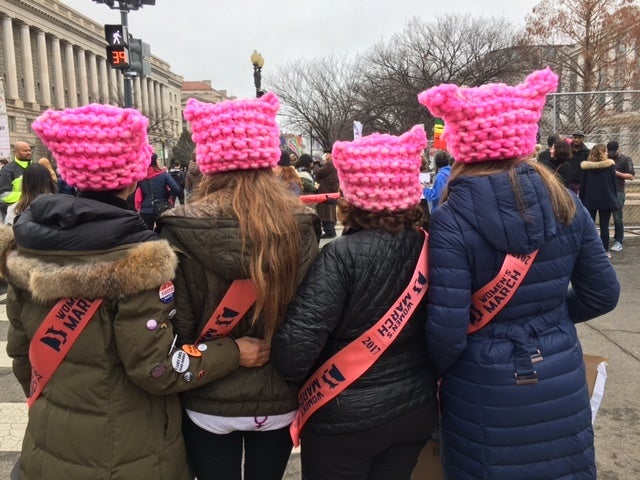
Nasty women, let’s strive to be more than nasty. Or to persist. Let’s stop selling each other shirts and hats and tattooing the words of anti-feminist men on our bodies. We don’t need more slogans, especially slogans derived from the mutterings of menfolk. We don’t need more merch. We need solidarity and foresight.
As we combat stubborn sexists and find ways to educate ourselves, them, and the disengaged, feminists should carefully analyze our messaging and the associated commodification/selling of that messaging. Commodification and ill-defined ideologies have been persistent concerns for feminism for decades and now is a crucial moment to collectively, and critically, take stock of the economics and rhetoric surrounding our new-found mobilization.
Commodification can help mobilization by promoting a movement’s visibility, to be sure, but it can also confuse things. And this conundrum is not new to feminism. In her recent book, Bitch zine co-founder Andi Zeisler aptly notes that corporations have co-opted women’s empowerment movements since the early-20th century. “It’s not a stretch to say that modern feminism was co-opted by the market almost as soon as it was born,” she explains, “The white, middle-class ‘new woman’ of the late nineteenth and early twentieth century, who had leisure enough to chafe against the Victorian ideal of the ‘angel in the house,’ was an early target of advertisers seeking a fresh demographic.” In her recent manifesto, Jessa Crispin also reviles the reduction of feminism to commodities and tells her readers that she no longer identifies as feminist. A reason she gives for abandoning the term is this capitalist swaying of feminism away from structural change and towards clichés. Concerns of activists like Zeisler and Crispin raise the question: have we substituted substance for salability?
Long-term corporate commodification has had confounding effects on the push for equality. A classic example comes from the cigarette ads of the 1960s and 70s, when Virginia Slims specifically targeted women by referencing the women’s liberation movement and using the tag line, “You’ve Come a Long Way, Baby.” Over the past decade, advertisers have opted for healthier (literally and figuratively) messages of empowerment and equality and I salute them. In 2014, for instance, Always released its “Like a Girl” campaign that celebrates powerful, strong girls and women. It also helped sell a ton of pads. Despite the evolution in the way companies are advertising to women, they are still selling something and these capitalist interests have not only continued to co-opt feminism, but their marketing campaigns have also worked to shape modern feminism to their own economic advantages.
What we are seeing with the current women’s movement, however, is not just marketplace feminism and “femvertising,” but grassroots commodification and branding. From pussy hats to “yet she persisted” tees sold on Etsy, the merchandise of the movement smacks of the same capitalist subversion engaged in by Cover Girl and Kotex and Diet Coke, etc., etc., ad nauseam. Are we reducing an ideology to objects to be purchased (or crafted, in some cases) rather than further defining it, expanding it, and working for systemic change? Our own commodification might be successful in marshalling more Americans to action (see the Women’s March on Washington,) but the language and methods of organization require some additional consideration.
Like the Always ad that inverts the meaning of the timeworn jest, “like a girl,” recent branding has often defined feminism as a reaction to male commentary and masculine culture. Pussy hats came about because of the infamous release of the recorded conversation between Billy Bush and Donald Trump where the now-president boasted that he could “grab [women] by the pussy.” They also play in to feminine stereotypes in a curious way. They are the classic pink that girl babies are adorned with in their cribs and they are often knit by crafty women, which unintentionally references the domestic separate sphere we’ve so long been told is our place. Appropriating the “pussy” comment is a great way to draw attention to the seriousness of the objectification of women. But how far will the hats go to further a serious agenda to combat the root of the problem: women are thought of, treated, addressed differently and we need systemic change to correct that.
Like the pussy hats, Trump is similarly responsible for the “nasty woman” campaign adopted by Hillary Clinton after he muttered those words during a presidential debate. In that one aside, he unwittingly gave birth to a whole industry of nasty woman paraphernalia. That industry also glommed on to the “nevertheless, she persisted” craze, which was derived from the condemnation of Senator Elizabeth Warren by (another man) Senate Majority Leader, Mitch McConnell. Many of the slogans and signals of today’s iteration of feminism and the women’s movement adopt the language of powerful men. I know we’ve got more to say than that. And this trend is indicative of the need to better articulate what feminism is (and is not simply measured against) and to analyze our iconography.
To be sure, the strategy of appropriating discriminatory language is not new and nor should it be rejected outright. Linguistic appropriation is a tactic successfully used by civil rights, LBGTQ rights, and women’s rights advocates for decades. By actively using words of oppression and bigotry, activists (including feminists) alter the meaning of language and diffuse the negative and denigrating views embedded in that language. The women’s movement, however, and the accompanying feminism has not demonstrated a coherence around a common, and inclusive, identity in order to effectively appropriate prejudiced language. In other words, we know what we are against. Now we must consider what are we for and if we can or even should market that on a hat or travel mug. While many of the products you can purchase provide some funding for Planned Parenthood and other worthy causes, the fact remains that supporters are literally buying in to a branded movement that is shaped at present as a reaction to statements made by men. Resistance is vital, but it will only take us so far. Building a united, intersectional, proactive feminism that doesn’t simply resist but responds and upends the system is even more important, and astronomically more difficult. And, to be fair, that is a far more difficult message to fit on a graphic tee.
